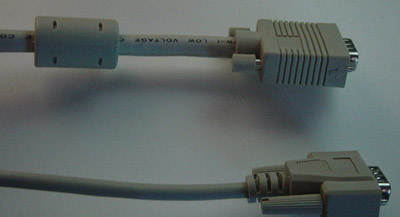LCD – For the Novice and the Expert
by Kristopher Kubicki on September 4, 2003 12:13 AM EST- Posted in
- Displays
Monitor cables
We stressed how important it is to make sure that the VGA cable stays in good condition. Unfortunately, sometimes proper care isn’t enough. Choosing the right monitor cable also plays a critical role in your signal quality.Trust us — you want to run DVI, if possible, all the time. (Check out the next section for more information on that debate.) Even though DVI cables are not immune to interference, analog connections often amplify the flaw and produce awful artifacts. With that in mind, you also should never buy cheap KVMs or VGA cables.
Click to enlarge.
A close-up of a good VGA cable versus a poor one. The good cable (upper) is much thicker due to its heavier insulation and also uses a heavy duty adaptor, which is much less likely to fail.The DVI cable will typically produce a clean signal up to 25 feet. A 15 pin VGA cable will degrade signal after about 6 feet. Thus, as a rule of thumb, we always encourage our readers to buy the shortest cables available. How will you know if your cable is too long?
All analog cables present fundamental flaws in their design. The analog signal is very prone to harmonic and spontaneous interference. You do not want your VGA cable to run parallel to power cables or AC to DC converters. In fact, you really do not want any cables or metal touching your cable. We might be a little retentive, but we put a 2" plastic sheath (HomeDepot, 10 cents per foot) over our monitor cable when benchmarking monitors.
Have you ever kicked your monitor cable and the screen turned red? A worn cable will ground parts of the signal on the DVI or analog cable, resulting in off-color images. From time to time, I get asked from someone to fix their monitor, only to find it has a three inch gash in the cable.











63 Comments
View All Comments
Anonymous User - Thursday, September 4, 2003 - link
A good article.I my self use CML174.Made a lot of difference to my eyes compared to CRT.
Anonymous User - Thursday, September 4, 2003 - link
Outstanding reading, thanks.mechBgon - Thursday, September 4, 2003 - link
Nice work, Kristopher. : )KristopherKubicki - Thursday, September 4, 2003 - link
#5 fixed it - sorry.#7 fixed that one too. Yeah rubbing pixels really doesnt do much good. I think NewEgg is going to be pissed when they find out I messed up their monitor pretty good.
#6 Say it aint so!! We want to be the only ones ;)
Kristopher
Shalmanese - Thursday, September 4, 2003 - link
Finally! It took long enough for you to get this out :). Great article, finally an article about LCD's which isn't full of opinion and hearsay.dvinnen - Thursday, September 4, 2003 - link
ok, maybie you did mean that. Hard to tell, you say you scuffed the monitor, then go on to tell other people how to do it...I problay just need some sleep...
dvinnen - Thursday, September 4, 2003 - link
Rubbing the pixils does more good then harm then?<<<Personally, it seems that rubbing the pixels does more good than harm so continue at your own risk.>>>
Might want to fix that one
dvinnen - Thursday, September 4, 2003 - link
good to hear it. Seems like alot of the hardware sites are getting there act together.Anonymous User - Thursday, September 4, 2003 - link
On page 6, where you talk about the cables in the picture (the sentence right below the picture), shouldn't the good cable be the *upper* one or am I missing something?KristopherKubicki - Thursday, September 4, 2003 - link
Yeah, new editors and kind of a revamped AT staff. We went through a lull period after we lost Matthew, but now we have some really good writers and a lot of great content to write about.Just wait till Computex and COMDEX - 3 and 4 reviews per day sounds about right.
Kristopher